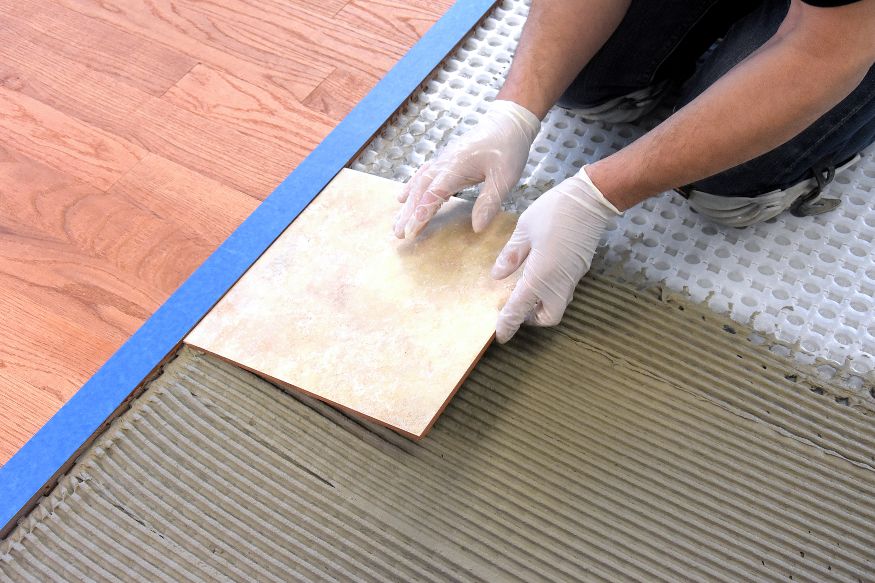
Don’t let cracked tile ruin an otherwise flawless flooring installation.
With a variety of easy-to-use solutions, our uncoupling and anti-fracture products help prevent cracks in the substrate from transferring to the tile layer, giving you a high-performing, long-lasting floor finish.
Our uncoupling membranes are designed to separate the tile layer from the substrate while minimizing floor height gain from tile installation materials whereas our anti-fracture membranes are designed to absorb stress and movement.
-
Product Sub Category
-
Warranties
x -
Country
Resources
FAQs - Common Questions We Get Asked
- What is uncoupling membrane?
An uncoupling membrane is an underlayment used under tile and stone installations to prevent stresses from transmitting up from the substrate. - When to use uncoupling membrane?
You can use an uncoupling membrane in industrial, commercial, and residential installations where an uncoupling or anti-fracture membrane is required. It's easier to install in relation to traditional underlayment materials such as cement backer board. - How does uncoupling membrane work?
An uncoupling membrane eliminates transmission of in plane substrate cracks of up to 1/8" (3 mm) when used in direct bond applications. Since the tile installation will be able to move independently from the substrate below. - What is Anti Fracture Membrane?
An anti-fracture membrane is a material used in construction and building applications to prevent or minimize the occurrence of cracks and fractures in flooring systems. It is typically installed between the subfloor and the finished flooring material, such as tiles, stone, or wood.The primary purpose of an anti-fracture membrane is to absorb and distribute stresses caused by structural movements, temperature fluctuations, or substrate shifts. These stresses can lead to the formation of cracks in the flooring material, which can be unsightly, compromise the structural integrity, and require costly repairs. - When is Crack Isolation Membrane Necessary?
Crack isolation is necessary in floors when there is a higher risk of cracks or fractures occurring in the flooring system due to various factors. Here are some situations where crack isolation is commonly recommended:- Substrate movement: If the subfloor or concrete slab has a history of movement or is expected to experience significant structural shifts, crack isolation is necessary. This can be due to factors such as settling of the building, expansion and contraction caused by temperature changes, or other dynamic forces.
- Substrate cracks: When there are existing cracks in the subfloor or concrete slab, crack isolation is essential. These cracks can potentially transfer to the finished flooring material if not properly addressed, leading to aesthetic issues and potential damage.
- Different materials: When installing dissimilar materials in the flooring system, such as tiles or stones with different coefficients of expansion, crack isolation is often recommended. Different materials expand and contract at different rates, and without proper isolation, this can result in cracks or failures at the transition points.
- Point loads or heavy loads: In areas where there will be concentrated point loads or heavy loads, such as equipment or machinery, crack isolation is necessary. These loads can exert excessive stress on the flooring system, increasing the risk of cracks or fractures.
By using crack isolation systems, such as anti-fracture membranes, it is possible to minimize the transmission of stress and movement to the finished flooring material. This helps to protect the integrity and appearance of the flooring, reducing the likelihood of cracks or fractures and prolonging its lifespan. It's important to note that the necessity of crack isolation may vary depending on factors such as local building codes, site conditions, and the specific flooring materials being used. Consulting with professionals and following manufacturer guidelines is crucial to determine the appropriate crack isolation measures for a particular project.
- When is Crack Isolation Membrane Necessary?
How to Install Crack Isolation Membrane for Tile? Crack Isolation membranes often referred to as anti-fracture membranes in the industry, are always to be installed per the manufacturer’s written installation instructions. Whether you choose a peel and stick, rolled adhesive applied, or a liquid applied product meeting the ANSI A118.12 Specification for Crack Isolation Membranes for Thin-Set Ceramic Tile and Dimension Stone Installations you will experience an ease of installation.Liquid applied crack isolation membranes are typically the easiest to install, requiring only the use of common paint rollers and brushes to apply the material correctly. While rolled rubber sound and crack isolation mats are often installed using a modified thinset adhesive. All crack isolation membranes will require a clean sound and suitable substrate per the manufacturer’s written installation instructions and be installed in accordance with industry standards, and local building codes.
For instructions on how to install 170.5 Sound & Crack Isolation Mat, FRACTURE BAN®, FRACTURE BAN SC and Blue 92 Anti-Fracture Membrane please review the product data sheets.
